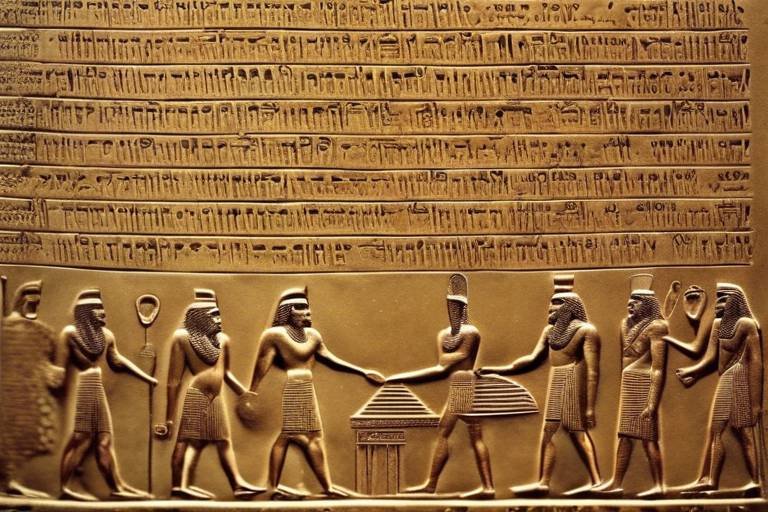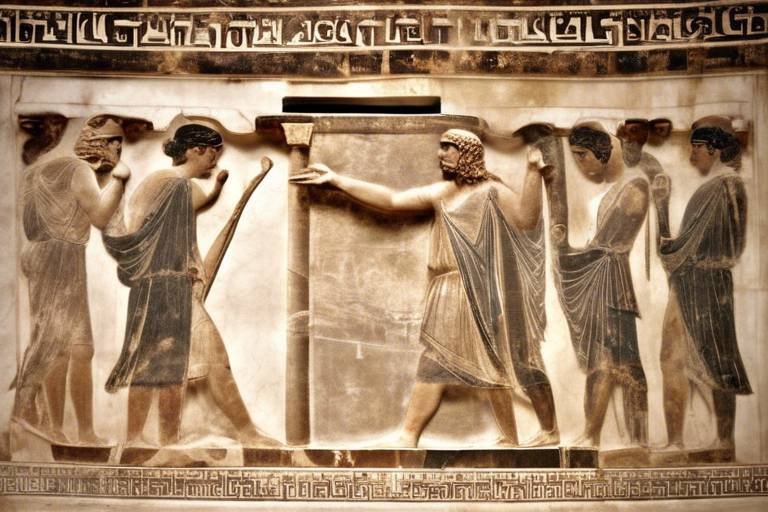The Secrets of the Ancient Babylonian Civilization
The ancient Babylonian civilization holds within its grasp a treasure trove of mysteries and advancements that continue to captivate historians and archaeologists alike. From the towering city of Babylon to the intricate web of religious beliefs, mathematical innovations, and artistic expressions, the Babylonians left an indelible mark on the annals of human history.
One of the most awe-inspiring aspects of Babylonian culture is the City of Babylon itself. With its grand architectural marvels and meticulous city planning, Babylon stood as the heart of the Babylonian Empire, a testament to the ingenuity and vision of its builders. The city's significance extended beyond its physical structures, serving as a hub of trade, culture, and power in the ancient world.
Delving into the realm of Babylonian religion unveils a complex tapestry of deities, rituals, and beliefs that shaped the spiritual landscape of the civilization. The Babylonians worshipped a diverse pantheon of gods and goddesses, engaging in elaborate ceremonies and practices that influenced later religious traditions. Their reverence for the divine permeated every aspect of life, from governance to daily activities.
Turning to the realm of Babylonian mathematics, we encounter a profound legacy of numerical ingenuity. The Babylonians made significant strides in mathematics, developing the sexagesimal system and laying the groundwork for early forms of algebra. Their mathematical prowess not only facilitated practical applications but also reflected a deep understanding of numerical concepts.
The Babylonian writing system, characterized by cuneiform script, played a pivotal role in preserving the knowledge and history of the civilization. Evolving over time, cuneiform inscriptions captured the essence of Babylonian culture, from epic tales to administrative records. Writing became a cornerstone of Babylonian society, ensuring the transmission of wisdom across generations.
One of the enduring legacies of Babylonian civilization is the famous Code of Hammurabi, a comprehensive legal code that outlined principles of justice and punishment. This codification of laws provided a framework for governance and social order, shaping the legal systems of future societies. The Code of Hammurabi stands as a testament to the Babylonians' commitment to justice and equity.
In the realm of astronomy, the Babylonians made remarkable advancements through their observations of the stars and planets. Their meticulous records and calculations laid the foundation for the development of the zodiac and influenced later astronomical studies. The Babylonians' keen interest in the cosmos reflected a deep-seated curiosity about the universe and its workings.
Exploring Babylonian art and culture unveils a rich tapestry of creative expression, from intricately crafted pottery and jewelry to monumental sculptures and decorative reliefs. Artistic endeavors flourished in Babylon, reflecting a society that valued beauty, craftsmanship, and cultural heritage. The artistic legacy of the Babylonians continues to inspire admiration and awe.
As we delve into the factors that led to the decline of the Babylonian Empire, we uncover a complex tapestry of invasions, internal strife, and shifting political landscapes. The legacy of Babylon endures in history, serving as a poignant reminder of the rise and fall of civilizations. Despite its eventual decline, the influence of Babylonian culture continues to echo through the corridors of time.

City of Babylon
Nine intriguing aspects of Babylonian culture, technology, and society that showcase the advanced and mysterious civilization that thrived in Mesopotamia thousands of years ago.
The City of Babylon stands as a testament to the architectural prowess of the ancient Babylonians. With its towering ziggurats, intricate city planning, and bustling markets, Babylon was the heart of the Babylonian Empire. The city's majestic gates, such as the Ishtar Gate adorned with vibrant blue tiles, welcomed traders and travelers from far and wide, symbolizing Babylon's status as a center of commerce and culture.
At the core of Babylon lay the Etemenanki, the famed ziggurat dedicated to the god Marduk, which soared into the sky like a stairway to the heavens. The city's layout, with its grid-like streets and organized neighborhoods, reflected a sophisticated urban planning system that was ahead of its time. Babylon's grandeur and strategic location along the Euphrates River made it a thriving metropolis and a symbol of power in the ancient world.
Moreover, Babylon served as a hub of intellectual exchange, where scholars and scribes gathered in the temples and libraries to record knowledge and history. The city's vibrant markets buzzed with activity, offering a glimpse into the daily life and trade that fueled the Babylonian economy. From the Hanging Gardens, one of the Seven Wonders of the Ancient World, to the majestic palaces of the kings, Babylon's architectural marvels continue to captivate the imagination and curiosity of historians and archaeologists alike.
Unveiling the complex pantheon, religious rituals, and beliefs of the Babylonians, including their influence on later religious practices.
Delving into the mathematical achievements of the Babylonians, such as the development of the sexagesimal system and early forms of algebra.
Examining the cuneiform script, its evolution, and the role of writing in preserving Babylonian knowledge and history.
Discussing the famous Code of Hammurabi, its significance in legal history, and the principles of justice and punishment in Babylonian society.
Revealing the Babylonians' advancements in astronomy, including their observations of the stars, planets, and development of the zodiac.
Exploring the artistic achievements of the Babylonians, from intricate pottery and jewelry to monumental sculptures and decorative reliefs.
Investigating the factors that led to the decline of the Babylonian Empire, including invasions, internal strife, and the legacy of Babylon in history.

Babylonian Religion
The Babylonian religion was a complex and intricate belief system that played a central role in the lives of the ancient Babylonians. At the core of their religious practices was a vast pantheon of gods and goddesses, each with specific domains and powers. These deities were worshipped through elaborate rituals and ceremonies, reflecting the Babylonians' deep reverence for the divine forces they believed controlled the world.
One of the most significant figures in Babylonian mythology was Marduk, the chief god who presided over the pantheon. Marduk's epic battle against the chaos dragon Tiamat, as recounted in the Epic of Creation, symbolized the triumph of order over chaos and served as a foundational myth for Babylonian cosmology.
The Babylonians also placed great importance on divination and astrology, believing that the movements of celestial bodies held profound significance for human affairs. Priests known as baru interpreted omens and studied the stars to discern the will of the gods and predict the future, shaping important decisions in both personal and political matters.
Furthermore, the Babylonian religion influenced later religious traditions, particularly in the development of astrology and the zodiac. The twelve signs of the zodiac, which originated in Babylonian astronomy, continue to be used in modern astrology, demonstrating the enduring legacy of Babylonian beliefs and practices.

Babylonian Mathematics
Nine intriguing aspects of Babylonian culture, technology, and society that showcase the advanced and mysterious civilization that thrived in Mesopotamia thousands of years ago.
Exploring the architectural marvels, city planning, and significance of Babylon as the heart of the Babylonian Empire.
Unveiling the complex pantheon, religious rituals, and beliefs of the Babylonians, including their influence on later religious practices.
Delving into the mathematical achievements of the Babylonians, such as the development of the sexagesimal system and early forms of algebra.
Examining the cuneiform script, its evolution, and the role of writing in preserving Babylonian knowledge and history.
Discussing the famous Code of Hammurabi, its significance in legal history, and the principles of justice and punishment in Babylonian society.
Revealing the Babylonians' advancements in astronomy, including their observations of the stars, planets, and development of the zodiac.
Exploring the artistic achievements of the Babylonians, from intricate pottery and jewelry to monumental sculptures and decorative reliefs.
Investigating the factors that led to the decline of the Babylonian Empire, including invasions, internal strife, and the legacy of Babylon in history.
The Babylonians were pioneers in the field of mathematics, laying the foundation for many mathematical concepts still used today. One of their most notable achievements was the development of the sexagesimal system, which is the basis for our modern measurement of time and angles. This system, based on the number 60, allowed for easier calculations and precise measurements.

Babylonian Writing System
Nine intriguing aspects of Babylonian culture, technology, and society that showcase the advanced and mysterious civilization that thrived in Mesopotamia thousands of years ago.
Exploring the architectural marvels, city planning, and significance of Babylon as the heart of the Babylonian Empire.
Unveiling the complex pantheon, religious rituals, and beliefs of the Babylonians, including their influence on later religious practices.
Delving into the mathematical achievements of the Babylonians, such as the development of the sexagesimal system and early forms of algebra.
Examining the cuneiform script, its evolution, and the role of writing in preserving Babylonian knowledge and history.
Discussing the famous Code of Hammurabi, its significance in legal history, and the principles of justice and punishment in Babylonian society.
Revealing the Babylonians' advancements in astronomy, including their observations of the stars, planets, and development of the zodiac.
Exploring the artistic achievements of the Babylonians, from intricate pottery and jewelry to monumental sculptures and decorative reliefs.
Investigating the factors that led to the decline of the Babylonian Empire, including invasions, internal strife, and the legacy of Babylon in history.
The Babylonian writing system, specifically the cuneiform script, was a cornerstone of their civilization. This intricate system of wedge-shaped characters etched into clay tablets was not only a means of communication but also played a crucial role in preserving the knowledge and history of the Babylonians.
Cuneiform writing evolved over centuries, starting as pictographs representing objects and evolving into a complex script with hundreds of characters. This writing system was used for various purposes, from recording business transactions and legal documents to writing epic poems and scientific texts.
One fascinating aspect of cuneiform is its ability to convey multiple languages. While originally designed for the Sumerian language, cuneiform was adapted to write Akkadian, the language of the Babylonians, as well as other languages in the region.
Tables were often used in cuneiform writing to organize information systematically. These tables covered a wide range of topics, including astronomical observations, mathematical calculations, and administrative records.
The meticulous nature of cuneiform writing allowed the Babylonians to create detailed historical accounts, religious texts, and literature that have provided modern scholars with valuable insights into their civilization.
Q: What materials were used for Babylonian writing?
A: Babylonian scribes primarily used clay tablets as the writing medium, which were then baked to preserve the inscriptions. They also used styluses made of reeds to create the wedge-shaped characters of cuneiform.
Q: How did the Babylonian writing system influence later civilizations?
A: The cuneiform script and the practice of writing on clay tablets influenced the development of writing systems in the ancient Near East, including those of the Assyrians and Persians. The legacy of cuneiform can be seen in the alphabetic scripts that followed.
Q: Were women involved in the Babylonian writing system?
A: While most scribes in ancient Babylon were men, there is evidence to suggest that some women were also trained in writing and participated in administrative tasks that required literacy.

Babylonian Law Code
The Babylonian Law Code, famously known as the Code of Hammurabi, stands as a testament to the sophisticated legal system of ancient Babylon. This comprehensive set of laws, inscribed on a stele, provided guidelines for various aspects of Babylonian society, covering matters of commerce, marriage, property rights, and crime. The Code of Hammurabi is revered for its principle of "an eye for an eye, a tooth for a tooth," reflecting the Babylonians' belief in proportional justice.
One of the remarkable features of the Babylonian legal system was its emphasis on social hierarchy and differentiating punishments based on the status of individuals. The Code of Hammurabi prescribed specific penalties for different classes of society, ensuring that justice was administered fairly, albeit with varying degrees of severity. This approach helped maintain order and stability within Babylonian communities.
Furthermore, the Code of Hammurabi provided insight into the values and priorities of Babylonian society. It highlighted the importance placed on family, property rights, and societal harmony. The laws aimed to protect the vulnerable, uphold moral standards, and regulate interactions between individuals, fostering a sense of accountability and mutual respect among Babylonians.
Despite the strict and at times harsh nature of the Code of Hammurabi, it also exhibited elements of compassion and equity. The laws included provisions for the protection of widows, orphans, and debtors, demonstrating a nuanced understanding of social welfare and the need for empathy in administering justice. This blend of rigidity and compassion set the Babylonian legal system apart and influenced legal practices in subsequent civilizations.
In addition to its practical application, the Code of Hammurabi served as a symbol of authority and legitimacy for the Babylonian rulers. By associating themselves with the divine origins of the laws, kings sought to establish their reign as just and ordained by the gods. The stele containing the code was prominently displayed in public spaces, serving as a constant reminder of the principles that governed Babylonian society.

Babylonian Astronomy
The Babylonians were pioneers in the field of astronomy, making significant contributions that laid the foundation for future astronomical studies. One of their remarkable achievements was the development of a sophisticated system to track the movements of celestial bodies. By meticulously observing the stars and planets, the Babylonians created detailed astronomical records that allowed them to predict celestial events with remarkable accuracy.
Central to Babylonian astronomy was the concept of the zodiac, a division of the sky into twelve equal parts, each associated with a specific constellation. This zodiac system, with its roots in Babylonian culture, later influenced Greek and Roman astronomy, shaping the way we understand the cosmos today. The Babylonians also recognized the significance of certain celestial events, such as eclipses, and recorded them diligently for future reference.
The Babylonians' observations of the night sky were not merely scientific pursuits but also had religious and astrological implications. They believed that the movements of the stars and planets held divine messages and could influence human affairs. This intertwining of astronomy with spirituality highlights the holistic approach of the Babylonians to the cosmos, where science, religion, and culture were intricately connected.
Furthermore, Babylonian astronomers developed a calendar based on lunar cycles, demonstrating their understanding of the celestial mechanics governing the passage of time. This calendar system, known as the lunar calendar, was a crucial tool for scheduling religious festivals, agricultural activities, and administrative tasks in Babylonian society. The precision and complexity of their calendar reflect the advanced astronomical knowledge possessed by the Babylonians.
In conclusion, Babylonian astronomy stands as a testament to the intellectual prowess and curiosity of this ancient civilization. Their observations of the heavens, development of astronomical systems, and integration of astronomy into various aspects of life showcase the depth of their knowledge and the sophistication of their culture. The legacy of Babylonian astronomy continues to inspire modern astronomers and reminds us of the enduring fascination with the mysteries of the universe.

Babylonian Art and Culture
Babylonian art and culture are a testament to the creativity and sophistication of this ancient civilization. The Babylonians excelled in various artistic forms, ranging from intricate pottery to monumental sculptures that depicted their beliefs and daily life. Their artistic achievements not only showcased their skills but also served as a means of expressing religious devotion and cultural identity.
One of the most notable aspects of Babylonian art is their mastery of decorative reliefs. These intricate designs adorned the walls of temples and palaces, depicting scenes of worship, battle, and royal ceremonies. The attention to detail and craftsmanship in these reliefs reflect the high level of skill possessed by Babylonian artisans.
Babylonian jewelry is another highlight of their artistic endeavors. The use of precious metals and gemstones in their jewelry pieces showcased their wealth and status. Intricately designed necklaces, bracelets, and earrings were not only decorative but also symbolic, often representing religious motifs or social hierarchies.
Moreover, Babylonian pottery was renowned for its exquisite designs and vibrant colors. From everyday household items to ceremonial vessels, Babylonian pottery displayed a wide range of artistic styles and techniques. The intricate patterns and motifs found on these pottery pieces provide valuable insights into Babylonian aesthetics and craftsmanship.
Additionally, the Babylonians were skilled in creating monumental sculptures that adorned public spaces and royal palaces. These sculptures depicted gods, goddesses, and mythical creatures, showcasing the Babylonians' religious beliefs and mythological narratives. The grandeur and scale of these sculptures reflected the power and influence of Babylonian rulers.
Overall, Babylonian art and culture not only reflected the artistic prowess of the civilization but also served as a means of preserving their history and beliefs for future generations to appreciate and study.

Decline of Babylon
The decline of the once magnificent Babylonian Empire was a gradual process marked by a series of significant events and factors that ultimately led to its downfall. One of the primary reasons for the decline of Babylon was the constant threat of invasions by neighboring empires and nomadic tribes. The Babylonians faced numerous military conflicts and invasions, weakening their power and control over the region.
Internal strife and political instability also played a crucial role in the decline of Babylon. The empire struggled with internal power struggles, rebellions, and conflicts among the ruling elite, leading to a weakened central authority and a lack of unity among the Babylonian people. This internal turmoil further exacerbated the empire's vulnerability to external threats.
Furthermore, the legacy of Babylon in history was also shaped by economic challenges and resource depletion. The empire's once thriving economy began to falter due to mismanagement, corruption, and a decline in trade routes. This economic downturn weakened Babylon's infrastructure and ability to sustain its vast empire.
As Babylon's power waned, its cultural and intellectual achievements also faced a decline. The artistic and scientific advancements that once flourished in Babylon began to fade as the empire struggled to maintain its influence and prosperity. The decline of Babylon marked the end of an era of innovation and cultural brilliance in Mesopotamia.
In the annals of history, the decline of Babylon serves as a cautionary tale of the fragility of empires and the inevitability of change. Despite its grandeur and achievements, Babylon could not withstand the challenges and pressures that ultimately led to its downfall. The legacy of Babylon continues to captivate historians and archaeologists, offering insights into the complexities of ancient civilizations and the forces that shape their rise and fall.
Frequently Asked Questions
- What was the significance of the City of Babylon?
The City of Babylon was a monumental architectural marvel that served as the heart of the Babylonian Empire. It was not only a center of trade and culture but also a symbol of power and grandeur in ancient Mesopotamia.
- How did Babylonian Mathematics contribute to modern math?
Babylonian Mathematics made significant contributions to the development of modern math, including the creation of the sexagesimal system and early forms of algebra. These innovations laid the foundation for future mathematical advancements.
- What is the significance of the Code of Hammurabi in legal history?
The Code of Hammurabi is one of the earliest known sets of laws in human history. It provided a comprehensive list of rules and punishments, establishing principles of justice and legal standards that influenced legal systems for centuries to come.
- How did Babylonian Astronomy impact our understanding of the cosmos?
Babylonian Astronomy advanced our understanding of the stars and planets through meticulous observations and the development of the zodiac. Their contributions to astronomy laid the groundwork for future astronomical discoveries.
- What are some key aspects of Babylonian Art and Culture?
Babylonian Art and Culture were characterized by intricate pottery, jewelry, monumental sculptures, and decorative reliefs. These artistic achievements reflected the creativity and sophistication of Babylonian society.


















